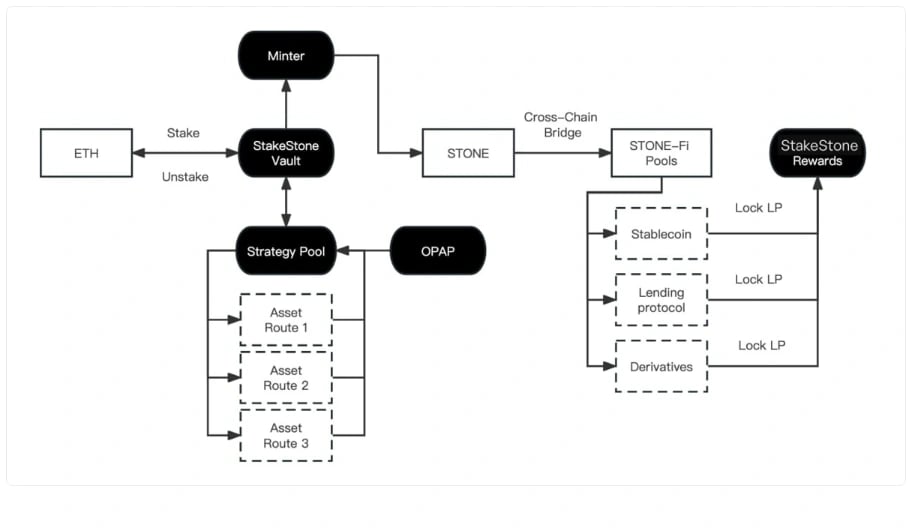Subscribe to wiki
Share wiki
Bookmark
StakeStone
The Agent Tokenization Platform (ATP):Build autonomous agents with the Agent Development Kit (ADK)
StakeStone
StakeStone is an omnichain liquidity infrastructure building STONE/STONEBTC, which serves as liquid ETH/BTC powered by an adaptive staking network. StakeStone supports major staking pools and is also compatible with upcoming restaking. It creates a multi-chain liquidity market based on STONE and liquid ETH, offering STONE users more use cases and yield opportunities. [1][2]
Overview
StakeStone pioneers the first decentralized solution for liquid staking through a mechanism called the Optimizing Portfolio and Allocation Proposal (OPAP). Unlike traditional approaches that rely on MPC wallets, StakeStone provides transparency for underlying assets and yields. Meanwhile, OPAP allows optimization of STONE’s underlying assets, ensuring STONE holders receive optimized staking yields. [6]
Based on LayerZero, STONE is a non-rebase OFT (Omnichain Fungible Token) that supports both assets and prices to be transferred across multiple blockchains. Developers on Layer2s can integrate STONE without additional complexities, leaving it as an accessible liquid ETH ready for mass adoption. [7]
STONE, the liquid ETH
STONE is a non-rebase ERC-20 token with the same mechanism as Lido's wstETH in terms of yield generation. Non-rebase means that the balance of STONE in a wallet will not increase. However, the value of STONE in ETH will increase as a result of the accumulated ETH staking yields. [3]
For instance, if user A deposited 100 ETH for 100 STONE, and one year later, the value of 1 STONE becomes 1.04 ETH, the user can withdraw 104 ETH from StakeStone with 100 STONE. [3]
STONE is also an Omnichain Fungible Token (OFT) based on Layerzero. This feature allows STONE to be bridged across different chains. Additionally, StakeStone utilizes Layerzero’s solution to develop customized contracts, further enhancing STONE’s cross-chain compatibility. [3][6]
Technology
OPAP
OPAP (Optimizing Portfolio and Allocation Proposal) mechanism is the first decentralized solution for optimizing liquid staking yields. Unlike traditional approaches that rely on MPC wallets, StakeStone provides transparency for underlying assets and yields. [4][5]
OPAP allows optimization of STONE’s underlying assets, ensuring STONE holders receive optimized staking yields automatically. [4]
StakeStone Vault
Management of deposit, withdrawal, and settlement
StakeStone Vault serves as the fund buffering pool, retaining the deposited ETH within the contract until a new settlement occurs, at which point it will be deployed to the underlying strategy pool. [5]
Minter
Minting and burning of STONE
The Minter function decouples STONE token minting from its underlying assets. This separation allows for independent adjustments to the underlying assets and the circulation of issued STONE tokens, ensuring a higher level of token stability. [5]
Strategy Pool
Asset yield routes whitelisting
Strategy pool adopts a whitelist mechanism governed by OPAP, demonstrating a high level of asset compatibility, such as staking pools, restaking protocols, and so on. Simultaneously, asset risks will be isolated within each individual strategy route, preventing cross-contamination of risks. [5]

See something wrong?
The Agent Tokenization Platform (ATP):Build autonomous agents with the Agent Development Kit (ADK)
